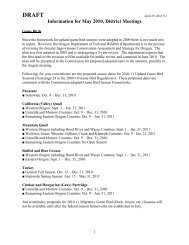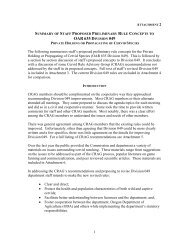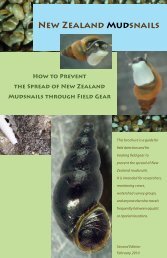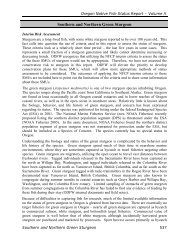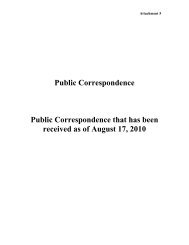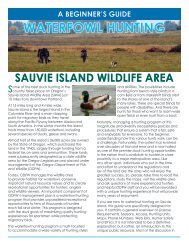SPOrT FISHIng regulaTIOnS - Oregon Department of Fish and Wildlife
SPOrT FISHIng regulaTIOnS - Oregon Department of Fish and Wildlife
SPOrT FISHIng regulaTIOnS - Oregon Department of Fish and Wildlife
Create successful ePaper yourself
Turn your PDF publications into a flip-book with our unique Google optimized e-Paper software.
Water Special Regulations<br />
Wallowa River (Wallowa Co.):<br />
• Open for adipose fin-clipped steelhead Jan. 1-April 15 <strong>and</strong> Sept. 1-Dec. 31.<br />
1. Mouth upstream to Rock Creek • Only adipose fin-clipped trout may be kept.<br />
2. Rock Creek upstream to Trout Creek • Open for adipose fin-clipped steelhead Jan. 1-April 15 <strong>and</strong> Sept. 1-Dec. 31.<br />
3. Upstream from Wallowa Lake to falls • Open May 25-Aug. 31.<br />
on West Fork <strong>and</strong> PPL intake on<br />
East Fork<br />
• Restricted to artificial flies <strong>and</strong> lures.<br />
Wenaha River (Wallowa Co.):<br />
• Open for adipose fin-clipped steelhead Jan. 1-April 15 <strong>and</strong> Sept. 1-Dec. 31.<br />
1. Upstream to Crooked Creek<br />
• 2 trout per day, 8 inch minimum length.<br />
• Catch <strong>and</strong> release for bull trout.<br />
2. From Crooked Creek to confluence <strong>of</strong> • 2 trout per day, 8 inch minimum length.<br />
North <strong>and</strong> South Forks.<br />
• Catch <strong>and</strong> release for bull trout.<br />
3. Remainder <strong>of</strong> Wenaha River Basin • 2 trout per day, 8 inch minimum length.<br />
(Upper South Fork <strong>and</strong> all tributaries). • Closed to angling for bull trout.<br />
Willow Creek Reservoir (Morrow Co.): • Catch <strong>and</strong> release only for largemouth bass.<br />
• Smallmouth bass per Zone Regulations, 5 per day, no more than 3 over 15 inches.<br />
• Crappie, 8 inch minimum length, daily bag limit <strong>of</strong> 25 fish.<br />
Willow Creek System (Morrow Co.):<br />
1. Slackwater at wildlife area<br />
• Open all year.<br />
2. Upstream from the wildlife area at the<br />
mouth<br />
• Open April 27-Oct. 31.<br />
The <strong>Oregon</strong> <strong>Department</strong> <strong>of</strong> <strong>Fish</strong> <strong>and</strong> <strong>Wildlife</strong> is moving its headquarters!<br />
ODFW’s headquarters is moving in the Summer <strong>of</strong> 2013. The new address will be:<br />
4034 Fairview Industrial Drive SE, Salem, <strong>Oregon</strong> 97302. This is near the Kuebler exit <strong>of</strong>f Interstate<br />
5 in south Salem. All telephone numbers for headquarters <strong>of</strong>fices will remain the same. Check for<br />
updated information concerning the move on the web at: www.dfw.state.or.us.<br />
Attention Anglers !<br />
Bull trout, one <strong>of</strong> <strong>Oregon</strong>’s native species, is listed as<br />
Threatened under the Endangered Species Act. Harvest<br />
<strong>of</strong> bull trout is severely restricted in <strong>Oregon</strong> as part <strong>of</strong><br />
conservation efforts to recover this species <strong>and</strong> rebuild<br />
the fishery. Please refer to regulations for the Willamette,<br />
Central, Northeast, <strong>and</strong> Southeast Zone regarding Bull<br />
trout.<br />
Research has shown that most anglers, experienced as well<br />
as inexperienced, have difficulty distinguishing between<br />
bull trout <strong>and</strong> brook trout, an introduced species in <strong>Oregon</strong>.<br />
This <strong>Fish</strong> Identification is provided to help you distinguished<br />
between native bull trout <strong>and</strong> introduced brook trout.<br />
Please help recover bull trout <strong>and</strong> restore the fishery by<br />
taking the time to learn the characteristics. Your help is<br />
essential!<br />
Brook trout <strong>and</strong> bull trout both have light spots on a dark<br />
grey or olive-green background. In general, bull trout have<br />
a clear dorsal fin, although in some fish light marks may<br />
be seen on the dorsal fin. Bull trout lack the worm-like<br />
markings on their backs <strong>and</strong> the red on their paired fins that<br />
characterize brook trout.<br />
Brook trout may be identified by light colored worm-like<br />
marking on their back, dark wavy lines on the dorsal fin,<br />
<strong>and</strong> red on the paired fins.<br />
Text highlighted in blue is new or changed from 2012<br />
Introduced Brook Trout<br />
Dark marks on<br />
dorsal fin<br />
Red on paired fins<br />
Native Bull Trout<br />
Worm-like markings on<br />
back<br />
No red on paired fins<br />
No dark marks on<br />
dorsal fin<br />
<strong>Oregon</strong> <strong>Department</strong> <strong>of</strong> <strong>Fish</strong> <strong>and</strong> <strong>Wildlife</strong> 75<br />
NORTHEAST<br />
Pages 70 - 75




